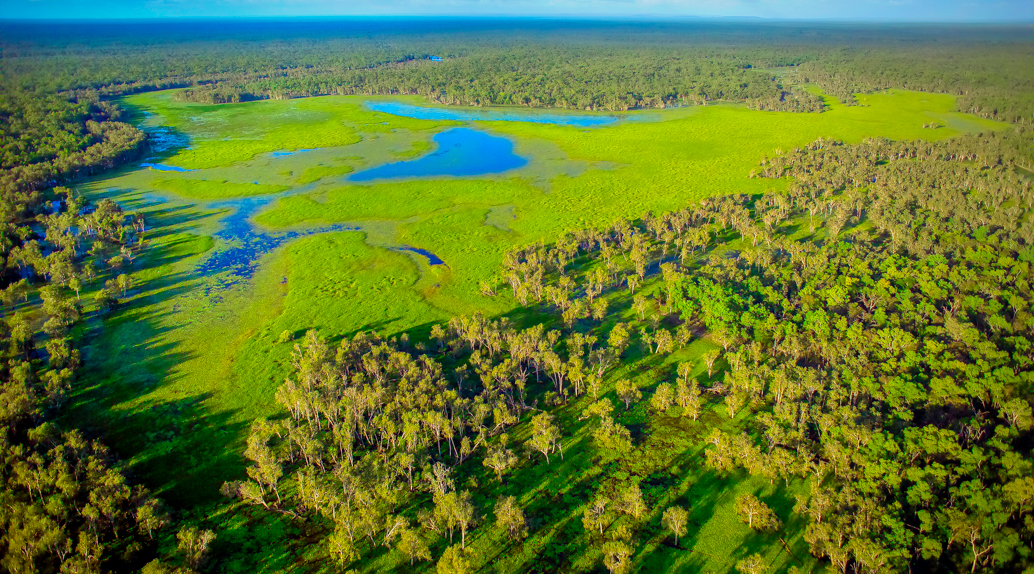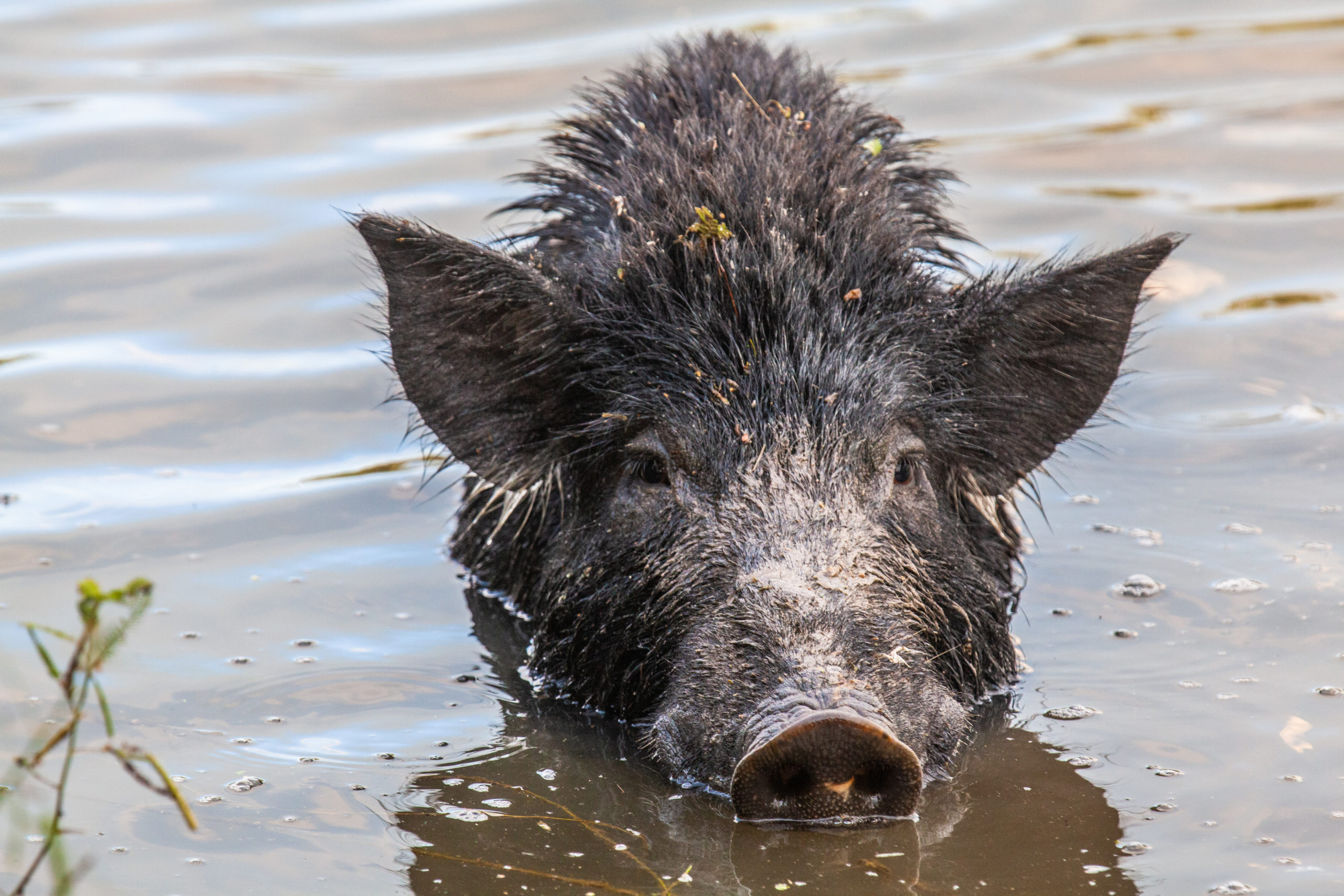Leading the charge against Cape York’s destructive feral pigs are AWC sanctuary managers, Graham Woods and Sally Gray, at Piccaninny Plains Wildlife Sanctuary.
They’ve successfully removed an astonishing 8,000 feral pigs since they began as managers (2013) and initiated a successful aerial shooting program (2015) at the remote north Queensland property.
Graham and Sally recently spoke to ABC News about AWC’s simple yet effective management strategy, which has reduced feral pig numbers to such low levels that crucial habitat has bounced back from devastation to glory – paying substantial ecological dividends.
 © Wayne Lawler/AWC
© Wayne Lawler/AWC
A big pig problem
Covering 165,000 hectares, Piccaninny Plains lies at the heart of Cape York Peninsula, in a region of global significance for conservation. The property contains stunning ecological diversity, protecting iconic wildlife like the Palm Cockatoo, Red Goshawk and Spotted Cuscus; and a mosaic of rainforest, woodland, grassland and wetland habitat.
Unfortunately, Piccaninny Plains (and the rest of Cape York) is under threat from the region’s many invasive species – especially feral pigs – which wreak havoc with devastating impact. As Sally explains,
“Cape York is known as the feral pig capital of the country. We couldn’t travel anywhere on the property without coming across feral pigs.”
 © Sally Gray/AWC
© Sally Gray/AWC
Feral pigs are incredibly destructive. On Piccaninny Plains, they cause devastating damage to wetlands, spread invasive weeds, dig up plants, spoil water quality (affecting fish populations), eat the eggs of emus, turtles and crocodiles, eat native mussels and land crabs, and impact negatively on ground dwelling wildlife like birds and goannas.
The sanctuary’s vulnerable wetlands are particularly susceptible to invasive pests. Piccaninny Plains contains 70 wetlands of national conservation significance. Prior to AWC’s acquisition, these wetlands were routinely destroyed by hordes of feral pigs. Sally said:
“The damage to wetlands, and really significant habitat, was dramatic. In the early days, the pigs would eat the turtles and mussels, dig up the wetlands, have an impact on the recruitment of native plants, and the water quality was terrible.”
Ecological recovery
Today, Piccaninny Plain’s wetlands are in beautiful condition. Safe from the environmental vandalism caused by thousands of feral pigs, they have been transformed to their former ecological glory, and restored to a level which once again supports an abundance of native life.
Among the many species to benefit is one of Australia’s most iconic birds, the Emu. Feral pigs predate upon Emu eggs, so their reduction has resulted in a significant increase in the abundance of Emus. Plant life has also significantly benefited; for example, lillies are no longer trampled and decimated, but able to return to the surface of the lagoons.
 © Sally Gray/AWC
© Sally Gray/AWC
The removal of pigs has also seen the evaporation rates in the lagoons themselves reduced, meaning that they hold water for longer – a vital lifeline for wildlife during the dry season. This is particularly important for the many migratory wetland bird species which use Piccaninny Plain’s lagoons as crucial habitat.
Winning the battle against feral pigs
Graham and Sally attribute their success to undertaking a monthly aerial pig control program – but it hasn’t been easy. When the program began, Graham and Sally were routinely seeing up to 100 pigs per mob, spread across huge areas. With only two of them to tackle the issue, alongside their other conservation duties, it’s been a huge undertaking. Sally said,
“A lot of the time people are overwhelmed with the problem. But we’ve been able to show that we can make a real difference on Country – with a fairly straightforward method, and just a couple of people”.
Persistence over many years has been key to our success on Piccaninny Plains and highlights the importance of AWC’s practical, long-term approach to conservation. Today, having significantly reduced feral pig numbers, and made a drastic improvement to habitat and native wildlife, it is clear to see that Sally and Graham’s hard work has definitely payed off.
“Now, we can travel 150 kilometres and we won’t see a pig”, said Sally.
Beyond the boundary
AWC, through Graham and Sally, continues to collaborate with the regional community to deliver a long-term and cohesive solution for controlling Cape York’s significant feral pig problem. As Sally explains,
“It’s really exciting to have a success story. The trick now is to get that same effort happening at a regional level.
Of course, pigs travel across boundaries. We need to get that regional effort going and it’s great that we’re starting to work towards that.”
Looking forward, the plan is to continue the aerial pig control program to maintain the suppression of feral pig numbers. Beyond the boundary, Graham and Sally will continue to share their strategy and experience with neighbouring properties in the region, in a bid to reduce feral pigs in the wider landscape.
Learn more about AWC’s work on Piccaninny Plains by watching Sally and Graham’s in-depth interview from our webinar series, AWC in Conversation.
Please help us protect threatened wildlife and habitat from invasive species
Donate now